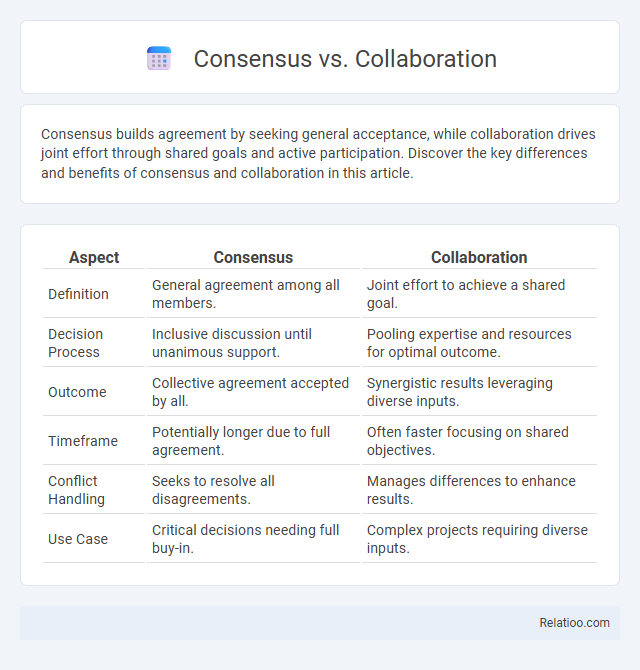Consensus builds agreement by seeking general acceptance, while collaboration drives joint effort through shared goals and active participation. Discover the key differences and benefits of consensus and collaboration in this article.
Table of Comparison
| Aspect | Consensus | Collaboration |
|---|---|---|
| Definition | General agreement among all members. | Joint effort to achieve a shared goal. |
| Decision Process | Inclusive discussion until unanimous support. | Pooling expertise and resources for optimal outcome. |
| Outcome | Collective agreement accepted by all. | Synergistic results leveraging diverse inputs. |
| Timeframe | Potentially longer due to full agreement. | Often faster focusing on shared objectives. |
| Conflict Handling | Seeks to resolve all disagreements. | Manages differences to enhance results. |
| Use Case | Critical decisions needing full buy-in. | Complex projects requiring diverse inputs. |
Understanding Consensus: Definition and Key Principles
Consensus is a decision-making process that seeks general agreement among group members by addressing objections and incorporating diverse perspectives. Key principles include mutual respect, active listening, and ensuring that all participants feel heard and valued, fostering widespread support for decisions. Unlike majority voting, consensus requires collective agreement, promoting shared ownership and commitment to outcomes.
Defining Collaboration: Scope and Core Concepts
Collaboration involves individuals or groups working synergistically towards a common goal, emphasizing shared responsibility, open communication, and mutual respect. Unlike consensus, which centers on unanimous agreement, collaboration focuses on leveraging diverse skills and perspectives to achieve innovative solutions. Your ability to foster effective collaboration hinges on creating an environment where trust and active participation enable collective problem-solving and value creation.
Consensus vs Collaboration: Main Differences
Consensus and collaboration are distinct processes where consensus involves reaching general agreement among all participants, ensuring everyone supports a decision, while collaboration focuses on working together to achieve a common goal without necessarily requiring unanimous agreement. Collaboration emphasizes collective effort and contribution, allowing diverse ideas to coexist and evolve, whereas consensus prioritizes unity and shared commitment before moving forward. Understanding these differences helps you select the appropriate approach for effective team dynamics and decision-making.
Benefits of Consensus in Decision-Making
Consensus in decision-making fosters collective agreement that enhances commitment and accountability among team members. It promotes diverse perspectives, leading to well-rounded solutions and increased trust within the group. This inclusive approach reduces conflicts and improves long-term implementation success by ensuring that all voices are heard and valued.
Advantages of Collaborative Approaches
Collaborative approaches foster diverse perspectives, enhancing creativity and problem-solving by involving all stakeholders in decision-making processes. These methods build trust and commitment, leading to higher-quality outcomes and increased acceptance of final decisions. Emphasizing shared goals and open communication, collaboration reduces conflicts and promotes continuous learning within teams and organizations.
Challenges of Achieving Consensus
Achieving consensus often faces challenges such as differing stakeholder priorities, communication barriers, and conflicts arising from diverse perspectives. Unlike collaboration, which allows for compromise and shared effort despite disagreements, consensus demands unanimous agreement, making it difficult in large or complex groups. Power imbalances and time constraints further complicate consensus-building, hindering efficient decision-making processes.
Obstacles to Effective Collaboration
Obstacles to effective collaboration often include miscommunication, lack of trust, and unclear roles, which hinder consensus-building and joint decision-making. Consensus requires all team members to agree, making collaboration difficult when divergent interests or power imbalances exist. Addressing these barriers through active listening, establishing shared goals, and fostering mutual respect enhances collaboration and consensus achievement in group settings.
When to Use Consensus or Collaboration
Consensus is ideal when Your team needs full agreement to move forward, ensuring every member supports the final decision. Collaboration is best used when pooling diverse expertise quickly, allowing for flexible input and iterative problem-solving without requiring unanimous approval. Use consensus for high-stakes decisions requiring commitment, and collaboration for dynamic environments needing rapid innovation and adaptability.
Impact on Organizational Culture
Consensus fosters collective agreement, promoting a culture of inclusion and shared responsibility within your organization. Collaboration encourages diverse input and teamwork, enhancing innovation and adaptability by valuing each member's contribution. Consensus emphasizes unity, but collaboration drives dynamic problem-solving, both shaping organizational culture through trust and mutual respect.
Best Practices for Blending Consensus and Collaboration
Blending consensus and collaboration in decision-making enhances team effectiveness by combining collective agreement with creative input. You should establish clear communication channels and set shared goals to ensure all voices are heard while driving toward a unified solution. Leveraging structured facilitation techniques and feedback loops helps balance diverse perspectives, fostering a productive and inclusive environment.

Infographic: Consensus vs Collaboration
 relatioo.com
relatioo.com